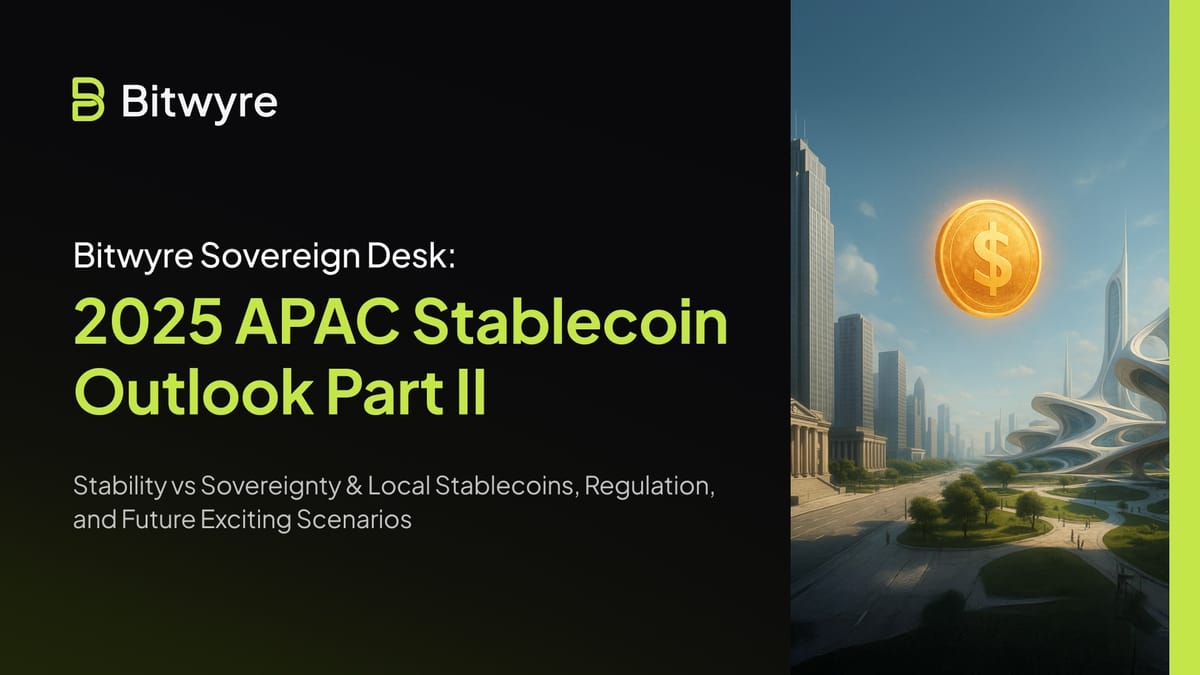Bitwyre’s Sovereign Desk: 2025 APAC Stablecoin Outlook Part II

Part II: Stability vs. Sovereignty & Local Stablecoins, Regulation, and Future Exciting Scenarios
The dominance of USD-pegged stablecoins in APAC’s crypto ecosystem raises a pivotal strategic question for governments: How to embrace the benefits of stablecoins without ceding monetary sovereignty? As the graphic above starkly illustrates, as of mid-2025, USD-backed stablecoins comprise almost the entire stablecoin market by value (Cointelegraph).
Stablecoin’s growth in Asia has largely been a digital dollar domination. For users and businesses, dollar stablecoins are attractive and pragmatic – they combine the dollar’s stability with seamless digital transfer.
But for policymakers, this trend can be double-edged. On one hand, stablecoins promise more efficient payments and financial inclusion; on the other, they could lead to currency substitution, where local currencies play a diminished role in their own economies.
This part of the report delves into how APAC governments and institutions are responding to the stablecoin boom, the rise (so far limited) of local currency stablecoins as an alternative, and scenarios for the future.
Welcome to the Sovereign Desk.
The Tightening Regulatory Responses
Regulators across Asia-Pacific have awoken to stablecoins’ growing prominence and are drafting bespoke frameworks at a rapid clip. Their responses span a spectrum from proactive embrace to outright prohibition, reflecting each jurisdiction’s economic priorities and risk appetite.
Proactive Embrace with Oversight
Singapore, Japan, Hong Kong, and now South Korea exemplify jurisdictions trying to strike a balance that permits stablecoin innovation under clear rules. Singapore’s approach, often dubbed “regulated innovation,” put out standards for issuers (100% reserves in low-risk assets, regular audits, redemption rights, etc.), effectively greenlighting single-currency stablecoins pegged to SGD or other G10 currencies as long as issuers are licensed.
This gave companies the confidence to launch products like XSGD within a supervised regime. Japan similarly amended its laws to recognize “digital money-type” stablecoins, which must be issued by licensed banks, trusts, or money transfer agents, thereby ensuring these tokens meet traditional e-money safety standards.
By June 2023, Japan’s framework was in force and by 2025 they even tweaked it to loosen some reserve requirements (to boost competitiveness) while adding guardrails like preventing illicit outflows. Hong Kong, as mentioned, passed its Stablecoin Ordinance in May 2025, requiring any issuer of a Hong Kong dollar stablecoin (or any stablecoin marketed in HK) to get an HKMA license and meet strict criteria.
The ordinance covers reserve management, capital, redemption at par, disclosure, and even marketing restrictions (only licensed stablecoins can advertise to the public). Hong Kong authorities explicitly want to avoid another Terra-like incident and also prevent unbacked “stablecoins” from duping consumers. Meanwhile, South Korea, having observed the stablecoin frenzy, is in the midst of legislating its own rules.
In June 2025, lawmakers proposed to allow a wide range of companies (with modest capital requirements) to issue won-based stablecoins under a new Digital Asset Act. Uniquely, Korea’s debate has been influenced by the political level – the new President was reported to support broad stablecoin adoption, seeing it as an innovative edge.
Even the Bank of Korea, initially cautious with its CBDC plans, appears to be going along: the BOK’s deputy governor publicly stated it’s “desirable to first allow banks… to issue won-based stablecoins and gradually expand” to other entities. This reflects a view that if stablecoins are inevitable, it is better to onboard regulated players (like banks) as issuers so that sovereign oversight is maintained in the first phase.
Restrictive or Cautious Stance
On the flip side, India and China have, to date, decided that private stablecoins pose too much potential risk to their controlled financial systems. China has effectively no legal room for private crypto; any digital payment innovation is funneled into its sovereign e-CNY.
Chinese regulators fear stablecoins would enable bypassing of the Great Firewall of capital control – for instance, citizens might convert yuan to USDT and move funds offshore, undermining limits on foreign exchange. Their blanket crypto ban since 2021 covers stablecoins, and they’ve enforced it by shutting down exchange access.
Hong Kong’s openness is a unique situation due to “one country, two systems,” but interestingly, some in mainland China’s regulatory circles are at least studying stablecoin implications. Reports suggest even a Shanghai regulator is pondering whether to respond to stablecoins in some way, likely to ensure they don’t erode the yuan’s usage in trade settlements.
India, as noted earlier, has not banned crypto outright but imposed draconian taxation and sought to discourage its use. Indian officials have explicitly lumped stablecoins into their concerns about crypto’s impact on macroeconomic stability. The RBI sees foreign stablecoins (USD, etc.) as potentially facilitating capital flight and reducing the efficacy of domestic monetary policy.
Essentially, if a large part of the economy switched to transacting in digital USD outside of banks, the RBI’s ability to control credit and money supply would weaken. It’s telling that India’s 2022-2023 CBDC pilots in wholesale and retail were framed as answers to crypto – offering a digital rupee so people wouldn’t need crypto alternatives.
By 2025, while India hasn’t introduced specific stablecoin laws yet, its officials are vocal in global forums about needing harmonized rules to prevent stablecoin misuse. They may well push for a de-facto ban or strict capital controls on stablecoin flows under the upcoming Indian crypto legislation.
Indonesia, Malaysia, and others fall somewhere in between: they haven’t banned stablecoins per se, but they caution that only national currency can be legal tender. One particular stablecoin with steady growth is IDRX. These countries are also exploring CBDCs, which suggests their strategy might be to allow stablecoins for trading and investment under securities or commodities rules, but not encourage their use as everyday money internally.
A common thread in the regulatory dialogues is that stablecoins are now recognized as potentially “systemically important” if they scale, thus needing “bespoke” treatment. Regulators worldwide (including APAC) coalesced around the principles that stablecoins should be fully reserved, promptly redeemable, operationally robust, and not entangle with risky lending or staking activities.
Very recently in the Philippines, several exchanges, including Bybit, KuCoin, OKX, and Bitget, are now blocked by local ISPs following SEC warnings, while app access remains but may soon be restricted. This sudden crackdown could be followed by some strict consequences.
The Rise (and Challenges) of Local Currency Stablecoins
One potential solution to the sovereignty dilemma is to develop local currency stablecoins, tokenised dollars are popular, yes, but what if we had robust stablecoins for rupees, rupiahs, yen, won, etc.? So in theory, local stablecoins could deliver the same technological benefits (fast, borderless transactions, on-chain programmability) while maintaining usage of the domestic unit of account.
Several APAC players are exploring this path, albeit with mixed progress so far. South Korea’s plan to launch a won-pegged stablecoin by a coalition of major banks is perhaps the boldest example.
The fact that eight top banks (including KB Kookmin, Shinhan, Woori, and even foreign bank units like Citi Korea and Standard Chartered Korea) have teamed up on this is significant. It signals a recognition that if they don’t offer a trustworthy won token, Korean crypto traders and businesses will simply use USD tokens.
The banks explicitly cite concern over “growing U.S. dollar dominance due to the rise of dollar-pegged stablecoins” as a motivation. They want to “put South Korea in a position to compete in global digital finance” while preserving the won’s role. The project, expected by late 2025 or early 2026, will likely create a 1:1 fully reserved digital KRW that can be used on crypto exchanges and potentially in payment apps.
The proposed model is a “trust-based 1:1 deposit token”, meaning each stablecoin is a direct claim on an equivalent bank deposit (or held in trust). The central bank governor did voice concerns that an easily convertible won token might paradoxically make capital outflows to dollars easier (one could quickly swap KRW-stable to USD-stable in a global market). This is a valid point: a liquid won stablecoin could inadvertently facilitate FX conversion at scale if not monitored.
However, the BOK isn’t against the idea; they just emphasize a gradual rollout and initial issuance by heavily regulated institutions (banks). South Korea’s approach may well become a case study: If successful, a won stablecoin could retain local users within the won ecosystem (for local trades, local commerce on-chain) and even be used regionally (perhaps Korean companies paying partners in Vietnam or Japan in a common interoperable network).
Japan’s Yen stablecoins are also coming to life under the new regulations. Several initiatives are worth noting, such as the Mitsubishi UFJ’s Progmat platform, which is building infrastructure for banks to mint stablecoins (not just yen, potentially other currencies too) on compatible networks; a startup-led project called JPYC that has been issuing prepaid yen tokens; and possibly collaborations like the one between MUFG and Binance Japan to issue JPY or other currency stablecoins on MUFG’s platform.
Moreover, the three megabanks in Japan, as mentioned, did a stablecoin-based remittance pilot using SWIFT’s network plus blockchain. The pilot’s expansion could see these banks issue “bank coin” stablecoins that are interchangeable. So by 2025, we may have multiple regulated JPY stablecoins, which could be used for domestic settlements (imagine on-chain stock trading or peer-to-peer transfers) as well as for international payments where both sides trust the Japanese banks’ token.
Further into finalising the deployment, just recently Japan is set to launch its first yen-denominated stablecoin, marking a major step in the country’s digital finance ecosystem. According to Nikkei News (Aug. 17), the Financial Services Agency (FSA) will this month approve the issuance of JPYC, a stablecoin pegged 1:1 to the Japanese yen.
The regulator will register JPYC Inc., the fintech behind the project, as a licensed remittance business, paving the way for sales to begin within weeks. To ensure price stability, JPYC will be backed by liquid assets such as Japanese government bonds, anchoring its value at 1 JPYC = 1 yen.
In Southeast Asia, local stablecoin efforts are still nascent but worth noting. We’ve already highlighted Singapore’s XSGD, which has proven that a local currency token can gain real transactional usage given the right environment. Its issuer StraitsX also offers XIDR (Indonesian Rupiah stablecoin) and even XPHP (Philippine Peso) in limited capacity. XIDR has been integrated on certain exchanges. Adoption is modest (market cap in the low millions), but it provides a blueprint.
Thailand saw an attempt with Terra’s Thai Baht token (THT) which was quickly declared illegal in 2021. Yet by 2024, as we saw, a fully regulated pilot with THBX stablecoin was conducted under the central bank’s sandbox.
In Malaysia, talk of a digital ringgit stablecoin has been quiet, possibly awaiting clearer crypto laws in the country (Malaysia has been focusing on crypto exchange licensing and not much on stablecoins specifically).
What are the challenges facing local stablecoins? First, network effects: Money likes liquidity. At present, USD stablecoins have the deepest liquidity: almost everyone accepts them–It is highly relevant–every exchange trades them, DeFi protocols have USD pools.
A local stablecoin in, say, Malaysian Ringgit (MYR) would start with almost zero network and would need concerted effort to get adopted. It might make sense largely within Malaysia, but even Malaysians might prefer holding a USD token if they’re concerned about MYR depreciation or if they want to interact with global crypto markets. This leads to the second challenge: value proposition.
A local stablecoin of a currency with high inflation or instability doesn’t solve the user’s desire for stability; it only digitises the volatile currency. For example, a hypothetical stablecoin pegged to the volatile Pakistani Rupee wouldn’t be attractive as a store of value. Pakistanis would rather use USDT to escape inflation. However, it could still have a role for domestic payment efficiency.
The third challenge is regulatory inertia. Ironically, the places that could benefit most from local stablecoins (countries with strict capital controls or weaker currencies) are the ones least likely to allow them, fearing they could create new channels for leakage or be hard to control once issued by private entities.
Despite these challenges, there is a compelling thesis echoed by experts in a neighbouring continent on the matter: local-currency stablecoins, ideally backed by high-quality liquid government assets, could enhance monetary resilience for emerging markets.
By issuing a stablecoin fully backed by, say, short-term government bonds, a country can potentially broaden demand for its debt (if the stablecoin is adopted abroad) and give its currency a new lease on life in the digital space. It’s a tall order for sure, but not impossible. If, for instance, a network of Southeast Asian countries each had robust stablecoins (digital SGD, IDR, THB, PHP), they could theoretically interlink them for regional trade, reducing dependence on the USD as intermediary.
We are witnessing stablecoins evolve in real time, evolving into increasingly regulated, institutionalised instruments inching toward mainstream legitimacy. The timeline above illustrates this transformation: from Facebook’s controversial Libra launch in 2019 that jolted G7 regulators into action, to the sweeping global policy responses now shaping the stablecoin landscape.
The crash of Terra UST in 2022 acted as a watershed moment, catalyzing legislative urgency from Brussels to Washington. By 2024, jurisdictions from the EU (MiCA) to Asia-Pacific hubs like Singapore and Japan had begun rolling out bespoke regulatory frameworks.
Navigating the Forks in the Road
Looking ahead, the trajectory of stablecoins in APAC could follow several plausible, interesting and exciting scenarios. These scenarios are not mutually exclusive, parts of each may unfold in different places. However, they may help us imagine outcomes and their exciting implications.
Dollar Stablecoin Dominance Continues Unabated
In this scenario, user preference and network effects keep USD-backed stablecoins (like USDT, USDC) firmly on top. Asia’s share of stablecoin flows (already >$500B in 2024 ) grows even larger as more people adopt digital dollars for saving and transactions.
If APAC economies continue to experience periods of currency volatility (e.g., a weakening yen or ringgit), this could accelerate dollar stablecoin usage as a hedge.
We might see unofficial dollarisation in certain niches – for example, e-commerce sellers in one ASEAN country preferring to settle in USDC to avoid currency risk. This would enhance economic efficiency in the micro sense (faster, cheaper payments), but could pose macro challenges.
If this then that: If USD stablecoins become deeply entrenched, then central banks may face a reduced ability to manage local liquidity, and they might respond with stricter capital controls on crypto.
Some countries might limit banks from interacting with stablecoin platforms or enforce conversion limits (similar to how some manage cash dollar flows). On the flip side, the U.S. dollar’s influence would increase – indeed, some analysts note stablecoins have expanded the dollar’s reach to places U.S. banks couldn’t easily serve.
The U.S. government itself may eventually support this dominance if regulatory clarity (like the proposed Stablecoin GENIUS Act in the US) passes, treating dollar stablecoins as extensions of the traditional system. That could make dollar stablecoins even more robust (legally recognised, FDIC-insured reserves perhaps), further solidifying their role in APAC usage. Under this scenario, local currencies might play a secondary settlement role or be used mainly in the domestic cash economy, while much of the digital economy rides on the back of digital dollars.
Rise of Sovereign and Local Stablecoins
An exciting multipolar stablecoin world. Here, we imagine that the current efforts at launching local stablecoins bear fruit, leading to a more diversified stablecoin ecosystem by, say, 2026.
If governments and consortia succeed in creating trusted and convenient local currency tokens, then users and businesses will have viable alternatives to USD tokens for many use cases. For example, South Koreans could choose KRW Coin for local commerce or even for trading Korean won-denominated crypto markets (perhaps global exchanges list a KRW stablecoin trading pair).
Japanese firms might settle intra-Asia trade in JPY stablecoin, especially if it’s integrated with partners’ banking systems. Over time, a network of regional stablecoins could emerge, potentially interoperating via cross-chain or common standards (imagine being able to swap a stable Singapore dollar for a stable Thai baht on a regional platform with minimal friction).
This scenario could reduce collective dependence on the U.S. dollar in the region – achieving some level of “digital de-dollarisation.” It might also strengthen local financial markets: for instance, a digital rupiah widely used in ASEAN could increase demand for rupiah assets. However, this outcome requires significant trust in local institutions. Not all countries have banks as globally trusted as, say, Japan or Singapore.
Smaller countries might rely on regional initiatives (perhaps an ASEAN stablecoin framework) to bootstrap credibility. If multiple local stablecoins prosper, then we might also see more currency swap arrangements on-chain, effectively linking reserve pools (e.g., MAS and Bank of Thailand might maintain each other’s token reserves for liquidity).
A big if here is public preference – will a Vietnamese user really prefer a digital dong to a digital dollar? Possibly yes for local payments (to avoid FX), but as a store of value, though likely no if inflation is high. So local stablecoins would need to come with macroeconomic stability to compete.
Here, monetary sovereignty is preserved or even enhanced: countries gain a new tool to extend their currency’s utility internationally. But it also means each stablecoin would be as strong as its issuer’s credibility; a loss of confidence (say a political crisis affecting the backing reserves) could still trigger flight to USD or another stablecoin.
Asia’s economic future has always involved a balancing act between embracing globalisation and maintaining local autonomy. Stablecoins encapsulate that tension in digital form. The coming years will test APAC regulators’ ability to craft intelligent policies that encourage the positive “disruption” (faster trade, better remittances, financial innovation) that stablecoins bring, while containing the risks (runaway dollarisation, consumer harm, illicit flows).
If there’s one thing the first half of 2025 has shown, it’s that stablecoins are not a passing crypto fad in Asia, but a foundational layer of the next-generation financial infrastructure.
Ponder not if stablecoins will be widely used in APAC – they already are – but rather consider who will shape their evolution and how their promise can be optimally realised for the economies and people of the region.
Sources: The analysis above is supported by data and insights from a range of Q1–Q2 2025 sources, including regulatory news from IFC Review, industry insights from Fireblocks, regional adoption reports by Chainalysis, financial press like Cointelegraph and PYMNTS on legislative developments and expert commentary from experts on the matter.
The Sovereign Desk editorial is open for conversation. If you’ve observed notable flows, rumours, or data points that warrant attention, please reach out to us:
Dendi Suhubdy at [email protected]
Faisal Mujaddid at [email protected]
Looking to execute large crypto trades with precision, privacy, and zero slippage? Schedule a call with the team at t.me/dendisuhubdy or shoot us an email at [email protected]. Bitwyre’s OTC desk handles high-volume transactions with deep liquidity and bespoke settlement.
We’re also rolling out a stablecoin payments app that lets you bypass OTC entirely, allowing you to use your stablecoins directly for payments at Visa-supported merchants worldwide. Sign up for the waitlist here.




